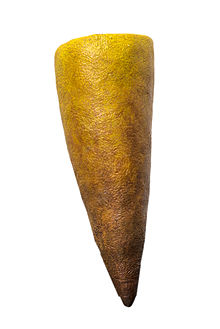Thectardis
This article relies largely or entirely on a single source. (February 2023) |
| Thectardis Temporal range: Ediacaran,
| |
|---|---|

| |
| Artist's reconstruction | |
| Scientific classification | |
| Kingdom: | Animalia (?)
|
| Phylum: | |
| Genus: | †Thectardis Clapham et al., 2004
|
| Species: | †T. avalonensis
|
| Binomial name | |
| †Thectardis avalonensis Clapham et al., 2004
| |
Thectardis avalonensis is a triangular-shaped member of the Ediacaran biota, dating from 574 to 565 million years ago.[1] The organism took the form of an elongated cone with a central depression, and its apex was anchored to the substrate.[2]
Morphology
[edit]The fossils take the form of a triangle with a central depression, suggesting that the original organism was conical. The diameter to height ratio of the organism is roughly constant in each location at 1 to 3 in the younger beds, and from 1 to 2.5 in the older beds. The constant ratio suggests that it grew by adding to its body at the base of the cone. The triangle has a raised margin about a quarter of the width of the triangle. The interior either is blank, depressed, or has some vague transverse markings. The impression occurs in the upper bed rather than the lower surface.[2]
Occurrence
[edit]A total of 205 specimens of Thectardis are known, from two bedding surfaces, separated by 2 km and 10 million years at Mistaken Point, Newfoundland.[2]
Thectardis bearing bedding surfaces also contain Charnia and Ivesheadia.[2]
Twelve specimens of Thectardis also known from a new location; these fossilised animal remains were discovered on the bedding planes of the Sonia Formation of Marwar Super Group, which is exposed in the Sursagar region of Jodhpur, India.[3]

Ecology
[edit]Water currents knocked down the triangles in the same direction, and where they fall on top of other objects they flex over the top. When alive, the organism probably stuck to the microbial mats that bound the Ediacaran sea floor, standing on their tips like a pin in a pin cushion, so that the organism would have resembled an inverted cone. They probably fed on suspended particles. As there is no evidence for a holdfast anchoring them to the sea floor, it remains a matter of speculation how they were attached.[2]
Etymology
[edit]The generic name Thectardis is derived from the Greek thektos, sharp-pointed, and ardis, arrow-point. The specific name derives from the Avalon Peninsula, where it was found. Thus, Thectardis avalonensis translates as "sharp arrow-point of Avalon (Peninsula)."[2]
See also
[edit]References
[edit]- ^ Jack J. Matthews; Alexander G. Liu; Chuan Yang; Duncan McIlroy; Bruce Levell; Daniel J. Condon (2020). "A chronostratigraphic framework for the rise of the Ediacaran macrobiota: new constraints from Mistaken Point Ecological Reserve, Newfoundland". GSA Bulletin. 133 (3–4): 612–624. doi:10.1130/B35646.1. S2CID 235086638.
- ^ a b c d e f Clapham, Matthew E.; Narbonne, Guy M.; Gehling, James G.; Greentree, Carolyn; Anderson, Michael M. (2004). "Thectardis avalonensis: A New Ediacaran Fossil from the Mistaken Point Biota, Newfoundland". Journal of Paleontology. 78 (6): 1031–1036. doi:10.1666/0022-3360(2004)078<1031:TAANEF>2.0.CO;2. JSTOR 4094931.
- ^ Parihar, V.S.; Hukmaram; Kumar, Pawan; Harsh, Anshul (2023). "Triangular-shaped Ediacaran fossil Thectardis avalonensis from the Sonia Sandstone, Jodhpur Group, Marwar Supergroup, western India" (PDF). Current Science. 124 (9): 1095–1100.
